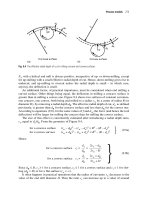cwdm technology applications and operations white paper pps
Bạn đang xem bản rút gọn của tài liệu. Xem và tải ngay bản đầy đủ của tài liệu tại đây (429.98 KB, 9 trang )
Wavelength Division Multiplexing (WDM) enables
carriers to deliver more services over their existing
optical fiber infrastructure by combining multiple
wavelengths on a single fiber. Each service is carried
over a separate wavelength, thus increasing the capacity
of the fiber by the number of wavelengths transmitted.
Coarse Wavelength Division Multiplexing (CWDM) and
Dense Wavelength Division Multiplexing (DWDM) are
both mature WDM technologies, using standardized
ITU-T wavelengths. CWDM and DWDM differ in
complexity, offered capacity, cost and the markets they
address. Due to its low cost and simple deployment,
CWDM is a good fit for access networks and many
metro/regional networks. This paper focuses mainly on
the CWDM technology and its applications, and explains
how carriers can use CWDM to cost-effectively
maximize their optical network capacity.
Wavelength Division Multiplexing (WDM) transports
multiple signals on a single optical fiber by using
different wavelengths to carry each signal. For a given
transmission line rate, WDM multiplies the amount of
data that can be carried over the same optical fiber by the
number of wavelengths transported.
WDM technologies have been in use since the 1980s,
and gained popularity with carriers after Dense
Wavelength Division Multiplexing (DWDM) became
standardized in the mid-1990s. DWDM enabled carriers
to extend the capacity of the SONET/SDH rings in the
network core, without installing new fiber. To cope with
increasing bandwidths demands, a new generation of
DWDM systems is being developed today.
While DWDM dominates the long haul network
segment, a different WDM technology, Coarse
Wavelength Division Multiplexing (CWDM) is now
well-positioned to help carriers maximize their network
capacity in the access, metro and regional network
segments. CWDM supports fewer wavelengths than
DWDM, but is available at a fraction of the cost of
DWDM. This makes CWDM attractive for areas with
moderate traffic growth projections. Proprietary
CWDM systems have been available since the 1990s,
but carriers have been reluctant to deploy solutions that
were not standardized. With full ITU-T standardization
completed in 2003, CWDM deployments will increase
dramatically.
Coarse Wavelength Division Multiplexing (CWDM)
provides a cost-effective alternative to DWDM in many
metro and regional networks, and provides a capacity
boost in the access networks. CWDM is technologically
simpler and easier to implement than DWDM, and it
addresses traffic growth demands without overbuilding
the infrastructure. For instance, a typical 8-channel
CWDM system, while inexpensive to deploy, offers 8
times the amount of bandwidth that can be achieved
using a SONET/SDH system, for a given transmission
line speed and using the same optical fibers.
ITU-T G.694.2 defines 18 wavelengths for CWDM
transport ranging from 1271 to 1611 nm, spaced at 20
nm apart. The complete CWDM grid is shown in Table
1. Due to high attenuations in the 1271-1451 nm band in
the commonly deployed optical fiber (G.652.A and
G.652.B) most CWDM implementations use 8
wavelengths in the 1471-1611 nm band.
Table 1
20 nm spacing was chosen to allow the effective use of
low-cost, uncooled lasers and wideband filters in
CWDM systems. The wideband filters tolerate variation
of +/- 6 to +/-7 nm from nominal in the received
wavelength, thus allowing a wider laser manufacturing
tolerance as well as the increased wavelength drift with
temperature associated with uncooled lasers. This means
that large, power-consuming thermo-electric cooling
circuitry is not necessary in CWDM systems. The
uncooled laser design largely accounts for the CWDM
systems’ small size, low cost, and low power
consumption.
CWDM systems rely on optical signal regeneration at
every node without the use of optical amplifiers. Since
all channels are regenerated at each node, the link power
budget does not depend on the number of channels
transported over each span. This simplifies the network
design.
Signal regeneration implies converting the signal from
optical to electronic form, and then reconverting the
signal from electronic back to optical form using OEO
(Optical-Electronic-Optical) transponders. With signal
regeneration, each wavelength requires its own
individual transponder. Signal regeneration makes sense
in networks with a limited number of spans and low
channel count.
For a high capacity DWDM system, attempting full
regeneration of all wavelengths at each node is an
expensive and complex proposition. But due to (a.) the
small number of wavelengths, (b.) inexpensive optics,
and (c.) recent compact size associated with CWDM
systems, the total cost of regenerative CWDM systems
can be kept low, with the added advantage of flexible
add-drop capability and network design simplicity.
These factors are especially critical to access network
deployments.
The distance between two CWDM termination points
can span up to 100km, depending on the interface speed
and the quality of optical fibers. This makes
regenerative CWDM systems suited for applications in
the metro-regional space, as well.
Fiber Exhaust Relief
Many metropolitan networks have not been upgraded for
a decade. Continuous increase in traffic has left some
areas with little or no room for growth. The lack of
network capacity, also known as fiber exhaust, is a
problem carriers are looking to solve immediately.
Adding CWDM in the optical transport is a simple and
cost-effective solution for fiber exhaust relief. New
services can be added over a single existing optical fiber,
without interrupting service to existing customers (see
Figure 1).
CWDM transponders take .85 , 1.3 and 1.5 -
band optical signals from a variety of sources such as
SONET and Ethernet client devices, and convert them to
CWDM wavelengths that are on the ITU grid (the use of
CWDM wavelengths is transparent to the client devices).
The converted signals are then optically multiplexed
onto the same fiber core, each service being carried on a
separate wavelength. Carriers can add Metro Ethernet
services to their SONET services, and integrate Ethernet
and SONET transport onto the same fiber (see Figure 2),
thereby enabling convergence of circuit and packet
services at the edge.
Typically, optical transmission systems such as SONET
use two fiber cores to achieve bidirectional transmission.
By using different wavelengths for each direction, a
CWDM system such as the NEC SpectralWave
MW0500, can transmit and receive traffic over a single
fiber core, thus cutting in half the number of optical
fibers that are needed for a given application (see
Figure 3).
CWDM is the perfect alternative for carriers who are
looking to increase the capacity of their installed optical
network without replacing existing equipment with
higher bit rate transmission equipment, and without
installing new fibers. By using CWDM, carriers will not
need to retire equipment before its time, or dig up the
ground to install new fiber. Installing new fiber is a
costly venture, especially in metropolitan areas, where it
impacts roads and terrestrial traffic.
Enterprise LAN and SAN connection
CWDM rings and point-to-point links are well suited for
interconnecting geographically dispersed Local Area
Networks (LANs) and Storage Area Networks (SANs).
Corporations can benefit from CWDM by integrating
multiple Gigabit Ethernet, 10 Gigabit Ethernet and Fibre
Channel links over a single optical fiber for point-to-
point applications or for ring applications (see Figure 4).
Low-cost WDM deployments in the metro
networks
Carriers serving smaller metro-regional areas with
moderate traffic growth projections can benefit from
deploying WDM systems with a reduced number of
channels. CWDM systems supporting a 4-channel
configuration, in addition to the more common 8-
channel configuration, present a compelling advantage
for smaller metro-regional markets. Systems with 4
channels can quadruple the available capacity over an
existing network segment, while offering a lower first-
in deployment cost than an 8-channel system. Carriers
can pay as they grow, and upgrade to 8 channel
systems when the network traffic justifies it. Low first-
in cost and scalability are of paramount importance in
such markets.
Central Office to Customer Premise
Interconnection
CWDM is a good fit for metro-access applications
such as Fiber to the Building (FTTB). An 8-channel
CWDM network can deliver 8 independent
wavelength services from the Central Office to
multiple business offices located in the same building.
The NEC SpectralWave MW0500 allows two Gigabit
Ethernet client signals to be multiplexed in the same
transponder (such a module is called a muxponder).
Thus for an 8-wavelength system, the NEC
SpectralWave MW0500 can deliver 16 independent
Gigabit Ethernet services (see Figure 5
Figure 5 – FTTB Application
For successful CWDM deployment, operation and
maintenance depend on the availability of management
functions that allow operators to monitor equipment
health and provision services remotely. Each CWDM
node in a network must collect status information
locally, and be able to autonomously report alarms and
allow an operator to retrieve performance information
and provision new services. This is typically done over a
LAN or WAN connection between the CWDM
equipment and the management console, by using a
network management protocol such as SNMP (see
Figure 6). In addition to an Ethernet port for connecting
to a management LAN or WAN, it is of great value to
have a separate optical service channel. The optical
service channel connects remote CWDM nodes and can
be used exclusively for transmitting management data
among CWDM nodes over the optical fiber, using
dedicated wavelengths.
Figure 6 – Remote Management Through External WAN
Through the optical service channel, a network operator
can retrieve performance information, issue maintenance
commands, and provision services at the remote end of a
CWDM link, even if the remote end is not connected to
a management LAN or WAN. In this case, the optical
service channel acts as a management LAN/WAN
extension over the optical fiber (see Figure 7).
Figure 7 – Remote Management Through Optical Service Channel
In cases where the remote end is connected to a
management LAN or WAN, the optical service channel
can provide a redundant management path. The optical
service channel can be configured to support chain and
ring topologies (see Figure 8).
Figure 8 – Redundant Management Path Through Optical Service Channel
CWDM is an attractive solution for carriers who need to
upgrade their networks to accommodate current or future
traffic needs while minimizing the use of valuable fiber
strands. CWDM’s ability to accommodate Ethernet and
SONET on a single fiber enables converged circuit /
packet networks at the edge, and at high demand access
sites. Given the low cost, simplicity, scalability and
management features of the latest products, CWDM
systems are now a sound alternative to overbuilding with
Next Generation SONET, DWDM, and proprietary
solutions. As traffic demands continue to rise, the
popularity of CWDM with carriers in the access and
metro networks will be akin to the popularity of DWDM
in the long haul and ultra-long haul networks.
About NEC Corporation of America
NEC Corporation of America is a leading technology
provider of network, IT and identity management
solutions. Headquartered in Irving, Texas, NEC
Corporation of America is the North America subsidiary
of NEC Corporation. NEC Corporation of America
delivers technology and professional services ranging
from server and storage technologies, IP voice and data
solutions, optical network and microwave radio
communications to biometric security, virtualization and
digital cinema solutions. NEC Corporation of America
serves carrier, SMB and large enterprise clients across
multiple vertical industries. For more information, please
visit www.necam.com.









